Ever thought about the fuel delivery app development cost?
Well, here's the scoop: the cost to develop a fuel delivery app can range anywhere from $30,000 to $150,000+, depending on a variety of factors.
But don’t let those numbers fool you- you-there are a ton of variables that can shift the cost of fuel delivery app development, making it higher or lower.
As convenience becomes a top priority for consumers, on-demand services are gaining serious traction.
People want what they need, when they need it, and that’s where the fuel delivery app market comes in.
Investors are catching on to this trend, leading many to search for the cost to develop a fuel delivery app. So, let’s break it down for you- without the jargon!
Let’s explore how to build a fuel delivery app that’s both innovative and profitable!
Why Develop a Fuel Delivery App?
Fuel delivery apps are changing the game by offering unmatched convenience. With a fuel delivery app, users can quickly get fuel delivered to their doorsteps, saving time and avoiding the hassle.
This makes it the perfect solution for residential users and anyone looking for an easy refueling experience.
For businesses, developing a fuel delivery app offers significant benefits.
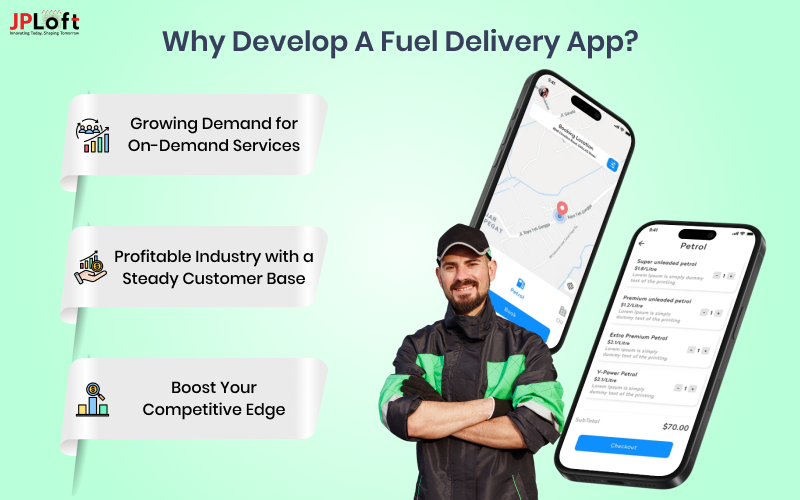
Let’s find what they are:
1. Growing Demand for On-Demand Services
People love convenience, and they’re willing to pay for it.
In fact, the on-demand economy is expected to reach a whopping $335 billion by 2025.
With more people looking for ways to simplify their lives, a fuel delivery app offers the perfect solution.
Just imagine- no more waiting in long lines at gas stations.
People can get fuel delivered to their doorsteps with just a few taps. The potential market is huge, and it's only growing.
2. Profitable Industry with a Steady Customer Base
Fuel delivery isn’t just convenient; it's also a lucrative business.
The global mobile fuel delivery system market is projected to reach $8.75 billion by 2032.
By developing an app that meets the demand for on-the-go fuel delivery, you’re tapping into a steady, recurring customer base.
Whether it's for vehicles or equipment, fuel is always in demand, meaning a sustainable business model for you.
3. Boost Your Competitive Edge
As the fuel delivery market grows, not every gas station or delivery service can keep up with the digital shift.
By creating a fuel delivery app, you position yourself as a forward-thinking business ready to meet modern consumer needs.
Consumers increasingly expect convenience from every service, and making a fuel delivery app is the key to standing out in a competitive industry.
Plus, it's a great way to attract tech-savvy customers who value ease of use and fast service. These are the reasons why investors should look forward to building their own fuel delivery apps.
Market Statistics and Trends
The on-demand fuel delivery market in the U.S. is booming, and it’s no surprise.
As people continue to rely on convenience for everything from food delivery to ride-hailing, fuel delivery services are gaining traction as the next big thing.
Here’s what’s happening in the market.
-
- Market Size: The global on-demand fuel delivery market is currently valued at around USD 0.33 billion.
- Projected Growth: This market is anticipated to grow to USD 2.04 billion by 2032.
- CAGR: The fuel delivery app market is expected to experience a compound annual growth rate (CAGR) of approximately 15.97%.
As this market continues to evolve, you should consult with an experienced mobile app development service provider with your app idea to enjoy a growing market with a huge earning potential.
How Much Does it Cost to Develop a Fuel Delivery App?
If you are wondering, “How much does it cost to develop a fuel delivery app?” then the answer depends on different factors.
The average cost to develop a fuel delivery app typically ranges from $30,000 to $150,000+, depending on various factors such as features,complexity, and development time.
Basic, Medium, and Advanced App Cost Breakdown
Below is a simplified comparison of costs for developing a basic, medium, and advanced fuel delivery app based on the features and complexity.
|
App Complexity |
Basic App |
Medium App |
Advanced App |
|
UI/UX Design |
$5,000 - $10,000 |
$10,000 - $15,000 |
$15,000 - $25,000 |
|
User App Features |
$10,000 - $15,000 |
$15,000 - $30,000 |
$30,000 - $45,000 |
|
Admin Panel |
$5,000 - $10,000 |
$10,000 - $20,000 |
$20,000 - $35,000 |
|
Driver App |
$7,000 - $12,000 |
$12,000 - $20,000 |
$20,000 - $35,000 |
|
Backend Development |
$20,000 - $35,000 |
$35,000 - $50,000 |
$50,000 - $75,000 |
|
AI Integration |
- |
$10,000 - $20,000 |
$30,000 - $50,000 |
|
Total Estimate |
$30,000 - $60,000 |
$82,000 - $135,000 |
$135,000 - $220,000 |
The cost of developing a fuel delivery app isn't just about throwing out random numbers.
There's much more to it.
To truly understand the fuel delivery app development cost, you need to consider the factors that influence it. And that's exactly what we're going to dive into in the next section.
Factors Affecting the Cost to Develop a Fuel Delivery App
Developing a fuel delivery app involves various stages, each contributing to the overall cost to create a fuel delivery app.
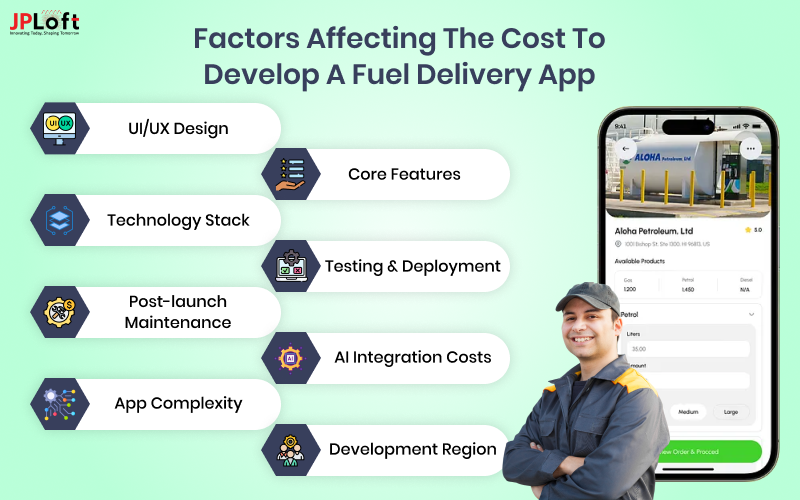
From designing an intuitive UI/UX to ensuring post-launch scalability, understanding the costs involved is crucial for effective budgeting.
1. UI/UX Design
UI/UX design plays a significant role in the success of your fuel delivery app. An intuitive, user-friendly interface enhances the user experience and makes your app stand out in a competitive market.
To decide how much does it costs to create a fuel and gas delivery app, you should know basic design doesn’t cost much, but going for advanced design can affect the cost.
|
Activity |
Approximate Cost Range |
|
Wireframes & Prototypes |
$5,000 - $12,000 |
|
Final Design Implementation |
$10,000 - $25,000 |
|
User Flow Design |
$3,000 - $8,000 |
|
Interactive Design |
$5,000 - $15,000 |
|
Design Testing & Revisions |
$2,000 - $6,000 |
|
Branding & Visual Elements |
$3,000 - $10,000 |
|
Responsive Design (Mobile & Web) |
$6,000 - $15,000 |
|
Usability Testing |
$2,500 - $7,500 |
When considering the cost to develop a fuel delivery app, investing in a seamless and easy-to-navigate UI/UX design should be prioritized.
An efficient design allows users to quickly order fuel, track deliveries, and make payments, boosting overall user satisfaction and retention.
2. Core Features
The core features of your fuel delivery app must provide a smooth experience for both users and administrators.
The app should be designed to handle fuel ordering, delivery tracking, real-time notifications, and analytics. The basic feature will be cost-friendly whereas the advanced feature might affect the cost to build an on-demand fuel delivery app.
|
Feature |
App Type |
Approximate Cost Range |
|
User Registration |
User App |
$3,000 - $6,000 |
|
Fuel Ordering |
User App |
$7,000 - $15,000 |
|
Real-Time Tracking |
User App |
$10,000 - $20,000 |
|
User Management |
Admin Panel |
$5,000 - $10,000 |
|
Fuel Inventory Management |
Admin Panel |
$8,000 - $15,000 |
|
Analytics |
Admin Panel |
$7,000 - $12,000 |
|
Route Optimization |
Driver App |
$6,000 - $12,000 |
|
Notifications |
Driver App |
$3,000 - $6,000 |
3. Technology Stack
Choosing the right technology stack is one of the biggest cost considerations in fuel delivery app development.
It’s important to select reliable technologies for the backend, frontend, databases, and third-party integrations to ensure scalability and app security.
|
Component |
Approximate Cost Range |
|
Backend (Server-side) |
$20,000 - $50,000 |
|
Frontend (Client-side) |
$15,000 - $35,000 |
|
Database & API |
$10,000 - $25,000 |
|
Third-Party Integrations |
$5,000 - $15,000 |
-
- Backend Considerations: For a fuel delivery app, backend technologies such as Node.js or Ruby on Rails will be used to manage the app’s database, user data, and real-time fuel tracking systems.
The backend must be secure and optimized for speed, which directly affects the cost to develop a fuel delivery app.
-
- Frontend Considerations: For the frontend, technologies like React Native or Flutter can help you create a cross-platform app for both Android and iOS at a lower cost.
The frontend design must offer an intuitive user interface that integrates seamlessly with backend services.
4. Testing and Deployment
Quality assurance (QA) is crucial to ensuring that your fuel delivery app runs smoothly and complies with industry standards. Proper testing reduces the risk of bugs and costly post-launch fixes. The more complex your app is, the more thorough testing is needed, resulting in increased costs to build an on-demand fuel delivery app.
|
Feature |
Approximate Cost Range |
|
QA Testing (Unit/Functional) |
$5,000 - $10,000 |
|
Compliance and Security |
$5,000 - $8,000 |
|
Deployment (App Stores) |
$3,000 - $7,000 |
|
User Acceptance Testing (UAT) |
$4,000 - $8,000 |
|
Performance Testing |
$3,500 - $6,000 |
|
Load Testing |
$4,000 - $7,500 |
The cost to create a fuel delivery app also includes comprehensive testing to ensure that the app functions as expected in real-world conditions.
This involves not just functionality testing but also stress testing to handle high traffic, especially in peak times like holidays or emergencies.
5. Post-launch Maintenance
Post-launch maintenance is often overlooked, but it is a key part of keeping your fuel delivery app running smoothly.
Ongoing updates, bug fixes, and scalability improvements are vital to maintaining customer satisfaction and expanding your business.
|
Feature |
Approximate Cost Range |
|
Bug Fixes & Updates |
$5,000 - $10,000/year |
|
Scalability Improvements |
$7,000 - $15,000/year |
|
Server Maintenance |
$3,000 - $6,000/year |
|
Security Updates |
$4,000 - $8,000/year |
|
Feature Upgrades |
$6,000 - $12,000/year |
|
Monitoring & Analytics |
$3,500 - $7,000/year |
After the launch, it’s important to factor in the cost to maintain a fuel delivery app. Regular updates for new features, user feedback, and system improvements are necessary to keep the app relevant and functional.
Furthermore, you’ll need to ensure the app scales as user demand increases.
6. AI Integration Costs
Artificial intelligence (AI) is becoming a growing trend in fuel delivery services AI-powered features such as route optimization, predictive maintenance, and dynamic pricing can significantly enhance the user experience and operational efficiency.
However, integrating AI comes with additional costs.
|
AI Feature |
Approximate Cost Range |
|
Route Optimization Algorithm |
$10,000 - $30,000 |
|
Predictive Analytics |
$15,000 - $40,000 |
|
Dynamic Pricing Model |
$10,000 - $20,000 |
Integrating AI into your fuel delivery app provides significant value but comes at a cost, and you need to hire dedicated developers to integrate them properly.
AI-based algorithms for route optimization can reduce delivery time, saving fuel costs and improving service efficiency.
7. App Complexity
A basic fuel delivery app will cost less than a feature-rich fuel delivery app. Features like real-time tracking, AI route optimization, and payment gateway integrations can all add to the price.
The more complex the features, the higher the on-demand fuel delivery app development cost.
|
Complexity Level |
Description |
Estimated Cost |
|
Basic App |
Basic fuel delivery features like user registration, fuel ordering, and payment integration. |
$30,000 - $50,000 |
|
Standard App |
Includes real-time tracking, geolocation, user profiles, and a payment gateway. |
$50,000 - $100,000 |
|
Advanced App |
Advanced features like AI route optimization, push notifications, real-time updates, and loyalty programs. |
$100,000 - $150,000+ |
8. Development Region
Once you have an idea, it is time to hire mobile app developers.
Where your app is developed plays a huge role in the cost to create a fuel delivery app. American developers typically charge more than those in other regions, like Eastern Europe or India, due to regional pricing differences.
|
Region |
Description |
Estimated Hourly Rate |
Total Estimated Cost |
|
North America |
High hourly rates due to regional pricing differences. |
$100 - $150 per hour |
$100,000 - $150,000+ |
|
Western Europe |
Moderate hourly rates with good quality development teams. |
$60 - $150 per hour |
$70,000 - $120,000 |
|
Eastern Europe |
Lower rates compared to North America, offering high-quality work. |
$40 - $80 per hour |
$50,000 - $90,000 |
|
India/Asia |
Significantly lower rates while maintaining good development quality. |
$20 - $50 per hour |
$30,000 - $70,000 |
So, these are some of the common factors that affect the fuel delivery app development cost.
But, there are many hidden factors that affect the cost to create a fuel delivery app
Hidden Factors That Affect the Cost To Make a Fuel Delivery App
Now, let’s talk about some of the hidden factors that often get overlooked when calculating the cost to create a fuel delivery app:
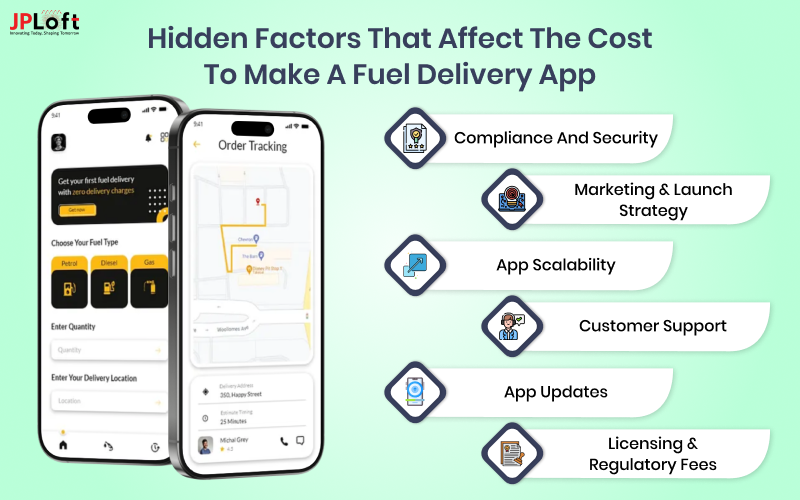
► Compliance and Security
Adhering to industry regulations and ensuring your app is secure can lead to extra costs. The last thing you want is a data breach or non-compliance issue.
Ensuring your app meets regulatory standards and is secure can add around 5%-10% to the overall cost.
|
Factor |
Description |
Estimated Cost Impact |
|
Compliance |
Adhering to legal and industry regulations to avoid potential legal issues and ensure data privacy. |
Adds 2%-5% to the overall cost. |
|
Security |
Implementing security protocols like encryption and secure payment gateways to protect user data. |
Adds 3%-5% to the overall cost. |
|
Total Cost Impact |
Ensuring both compliance and security measures are in place to protect the app and its users. |
5%-10% of the total cost. |
► Marketing and Launch Strategy
Once you submit your app to the App Store or publish your app to Play Store, the work is not over.
To ensure your app reaches your target audience, you’ll need a solid marketing plan. Costs for marketing campaigns, social media, and advertisements can significantly affect your overall budget.
A marketing and launch strategy can add 10%-15% to your development costs, as a successful launch is vital for user adoption.
|
Factor |
Description |
Estimated Cost Impact |
|
Pre-Launch Marketing |
Costs for creating awareness before the launch, including social media campaigns and influencer partnerships. |
Adds 5%-7% to the overall cost. |
|
Launch Strategy |
Costs for advertising, app store optimization, and promotions to ensure visibility and user acquisition post-launch. |
Adds 5%-8% to the overall cost. |
|
Total Cost Impact |
Effective marketing and launch strategy to ensure successful app adoption. |
10%-15% of the total cost. |
► App Scalability
As your fuel delivery app grows, scalability becomes essential. Ensuring your app infrastructure can handle increasing traffic without performance issues requires investment in backend systems, cloud hosting, and load balancing.
This can add another 5%-10% to your development costs, ensuring that your app can handle future growth.
|
Factor |
Description |
Estimated Cost Impact |
|
Backend Infrastructure |
Investment in servers, databases, and backend systems to support large-scale usage. |
Adds 3%-5% to the overall cost. |
|
Cloud Hosting |
Setting up scalable cloud infrastructure for flexible resources and performance optimization. |
Adds 2%-4% to the overall cost. |
|
Load Balancing |
Ensuring your app can handle increasing traffic without affecting performance. |
Adds 1%-2% to the overall cost. |
► Customer Support
Ongoing customer support can have hidden costs that increase over time.
Offering responsive and effective customer service through live chat, call centers, or help desks can add 3%-5% to your budget, especially if you want to provide a top-notch user experience post-launch.
|
Factor |
Description |
Estimated Cost Impact |
|
Support Channels |
Offering support through live chat, call centers, or email to resolve user issues. |
Adds 2%-3% to the overall cost. |
|
Ongoing Maintenance |
Costs for maintaining a support team and ensuring the app runs smoothly post-launch. |
Adds 1%-2% to the overall cost. |
|
Total Cost Impact |
Providing ongoing, responsive customer service to enhance user experience. |
3%-5% of the total cost. |
► App Updates and Feature Enhancements
As technology and user preferences evolve, your app will require regular updates and new features to stay competitive.
Adding new features, improving the user interface, or upgrading technology stacks can incur additional costs, contributing another 5%-10% to your overall maintenance budget.
Estimating the exact cost is one of the most crucial challenges in developing a fuel delivery app, and these factors play a significant role in deciding it.
|
Factor |
Description |
Estimated Cost Impact |
|
Feature Enhancements |
Adding new features, improving user interface, or adding functionalities based on user feedback. |
Adds 3%-5% to the maintenance cost. |
|
Technology Upgrades |
Regularly update the tech stack to stay competitive and ensure the app remains up-to-date. |
Adds 2%-4% to the maintenance cost. |
|
Bug Fixes and Patches |
Addressing bugs and issues to ensure smooth app performance. |
Adds 1%-2% to the maintenance cost. |
|
Total Cost Impact |
Ongoing updates to enhance user experience and adapt to new trends. |
5%-10% of the |
► Licensing and Regulatory Fees
When developing a fuel delivery app, there are often licensing and regulatory fees that need to be paid to ensure that the app complies with local laws and regulations.
These fees can vary depending on the country, region, or even city in which you plan to operate, especially in industries that deal with hazardous materials like fuel.
These licenses may cover things like operational permits, insurance, and safety certifications.
Overlooking this hidden fuel delivery app development cost can lead to legal issues down the line.
Safety certifications. Overlooking these costs can lead to legal issues down the line.
|
Factor |
Description |
Estimated Cost Impact |
|
Operational Licenses |
Fees for obtaining business licenses and permits required to operate legally in specific regions. |
Adds 2%-5% to the overall cost. |
|
Insurance & Safety Certifications |
Costs for insurance coverage and ensuring that your fuel delivery process complies with safety standards. |
Adds 3%-5% to the overall cost. |
|
Regulatory Compliance Fees |
Fees for complying with regional fuel distribution regulations, including environmental and transportation laws. |
Adds 1%-2% to the overall cost. |
|
Total Cost Impact |
Costs for securing necessary legal permissions and certifications to operate within the fuel delivery industry. |
6%-12% of the total cost. |
These hidden factors are crucial to keep in mind to avoid surprises down the road when estimating the cost to develop a fuel delivery app.
Top Fuel Delivery Apps in 2025
As the demand for convenience and fast service continues to grow, fuel delivery apps are in the limelight and becoming an important part of our lives.
Let’s get to know some of the top players in the market in 2025; knowing about them and what stands them out might help you to launch a better and more successful app.
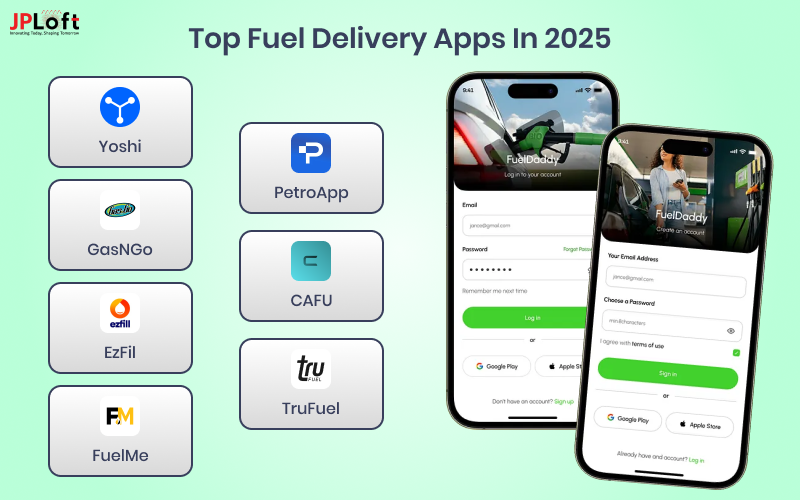
1. Yoshi – The Future of Fuel Delivery
Yoshi is a top fuel delivery app in the market.
It makes refueling as simple as tapping a button. This app brings the fuel to your car, wherever you are.
With options for fuel delivery directly to your driveway or workplace, it's perfect for busy drivers.
Cost to Clone: $30,000 to $100,000+
2. PetroApp– Fuel Delivery at Your Convenience
PetroApp helps you avoid the hassle of waiting in line at the gas station. It offers on-demand fuel delivery directly to your vehicle, offering both convenience and time savings for busy people.
Cost to clone: $40,000 - $70,000+
3. GasNGo – Effortless Fuel at Your Door
GasNGo takes fuel delivery to the next level, providing same-day service in major cities. With a simple, intuitive interface, this app ensures that you’ll never run low on fuel again.
Cost to clone: $70,000 - $100,000
4. CAFU – Fueling Your Ride with a Tap
CAFU is one of the most well-known fuel delivery apps in the Middle East.
It offers on-demand fuel delivery straight to your car with just a tap. With a simple and user-friendly design, it makes refueling faster and easier than ever.
Cost to Clone: $20,000 to $50,000+
5. EzFil – Simplified Fueling Solutions
EzFil provides a fast, convenient, and contactless fuel delivery service. By using the app, users can select their fuel type and schedule a delivery at their convenience. Whether for personal or commercial vehicles, EzFil makes fueling hassle-free.
Cost to Clone: $20,000 to $130,000+
6. TruFuel – On-Demand Fueling Made Easy
TruFuel provides high-quality, fast fuel delivery services tailored for both personal and commercial vehicles. The app offers instant booking and delivery, allowing drivers to avoid the gas station altogether.
Cost to Clone: $30,000 - $65,000+
7. FuelMe – Fueling at Your Fingertips
FuelMe offers a simple and effective fuel delivery service, allowing users to select their fuel type and schedule a delivery at their convenience.
It’s the ideal solution for urban dwellers who hate waiting at the pump.
Cost to Clone: $30,000 - $60,000+
How to Optimize the Development Cost of Fuel Delivery Apps?
When it comes to the cost to create a fuel delivery app, you don’t want to break the bank while still offering a great user experience.
Optimizing development costs is all about focusing on the essentials, choosing the right technology, and making smart decisions early on.
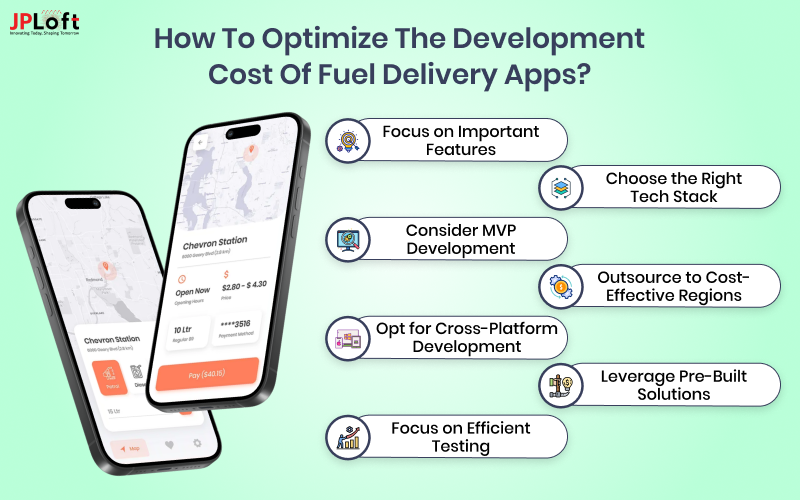
Let’s talk about a few ways you can lower the on-demand fuel delivery app development cost without sacrificing quality.
1] Focus on Important Features
When building your app, focus on the core features first. Start with basic functionalities like user registration, ordering, payment gateway, and location tracking.
By cutting out unnecessary features in the beginning, you’ll lower the cost to build a fuel app. This could reduce your development costs by 20%-30%.
2] Choose the Right Tech Stack
Picking the right technology stack can make or break your budget. Choose a tech stack that fits the app’s requirements but doesn’t overcomplicate things.
A well-chosen stack helps streamline the process, cutting down on time and cost. This could save up to 15%-20% of the overall development cost.
3] Consider MVP Development
Instead of launching with a fully-featured app, consider an MVP (Minimum Viable Product). An MVP allows you to release only the essential features first, collect user feedback, and improve iteratively.
This approach can reduce the on-demand fuel delivery app development cost by up to 40%, helping you avoid unnecessary expenses upfront.
4] Outsource to Cost-Effective Regions
If you’re looking to save on labor costs, consider outsourcing development to regions where labor rates are lower but the quality is still high (such as Eastern Europe or India).
This could lower the cost to create a fuel delivery app by 30%-50%, depending on the development team’s location.
5] Opt for Cross-Platform Development
Instead of developing separate apps for iOS and Android, consider using a cross-platform development framework like Flutter or React Native.
This way, you can launch on both platforms with just one codebase.
This will reduce your development costs by 25%-40%, cutting down on time and resources.
6] Leverage Pre-Built Solutions
Using pre-built solutions like SDKs (Software Development Kits) or APIs for features like payment processing or location tracking can save significant development time and effort.
You don’t have to reinvent the wheel; just integrate ready-made solutions.
This can reduce your cost to create a fuel delivery app by 20%-30%, as it cuts down on custom development time.
7] Focus on Efficient Testing
Rather than conducting multiple rounds of extensive testing at the end of the development phase, integrate testing throughout the entire process.
This will help identify bugs early and prevent costly fixes later on.
Efficient app testing can reduce your on-demand fuel delivery app development cost by up to 15%, as it avoids last-minute rework and delays.
These are some of the effective ways to optimize your costs. Now, with this out of the way, it is time to take a look at how we can earn the invested money back.
Monetization Strategies for a Fuel Delivery App
When considering the cost to create a fuel delivery app, it's essential to plan for effective monetization strategies that will ensure your business remains profitable.
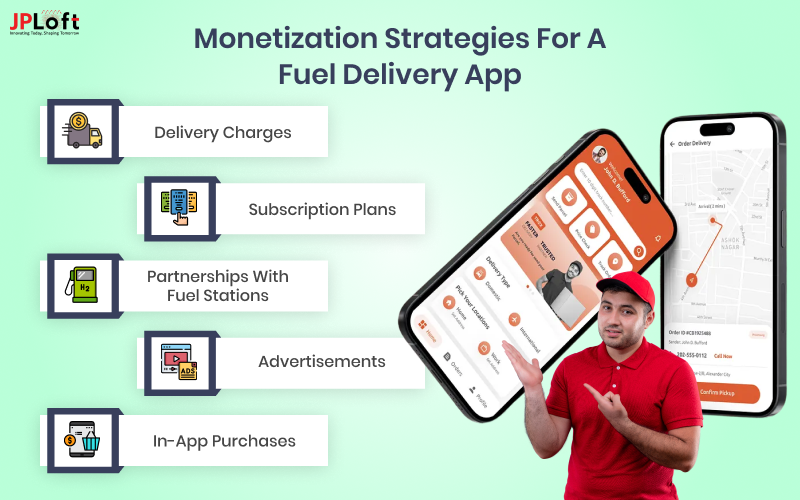
Here are the top ways to generate revenue from your fuel delivery app:
1. Delivery Charges
A straightforward approach to monetizing a fuel delivery app is charging delivery fees. The cost of delivery can vary based on distance, fuel order size, or location, allowing you to scale pricing based on demand.
This ensures that operational costs are covered while generating steady revenue from each delivery.
2. Subscription Plans
Introducing subscription plans is another highly effective revenue model. By offering premium services like priority delivery or discounts for frequent customers, you can create long-term customer loyalty.
These monthly or yearly subscriptions can significantly offset the cost to develop a fuel delivery app, providing a reliable income stream.
3. Partnerships with Fuel Stations
Partnering with fuel stations creates another revenue avenue. With a commission-based model, you can earn revenue by collaborating with fuel providers and earning a percentage from each order made through the app.
This business model is often a core revenue generator for many fuel delivery apps.
4. Advertisements
Ads are proven money-making models.
Monetizing your app through targeted advertisements can help maximize traffic and boost revenue without increasing delivery costs.
With in-app ads related to fuel services or automotive products, you can generate passive income.
5. In-App Purchases
Offering in-app purchases such as accessories, lubricants, or additional fuel-related services helps drive extra revenue. How to develop a fuel delivery app?These add-ons increase the average transaction value and can be crucial when calculating the total cost to create a fuel delivery app.
With these monetization strategies, your fuel delivery app can generate consistent income while keeping user satisfaction high and ensuring the long-term viability of your business model.
How JPLoft Can Help You Develop a Robust Fuel Delivery App
Building a fuel delivery app that’s secure, scalable, and user-friendly requires expertise and a deep understanding of the industry. That’s where we come in.
At JPLoft, as a leading fuel delivery app development company, we specialize in developing fuel delivery apps that are secure, scalable, and user-friendly. Our expert team offers tailored solutions to meet your specific needs, whether you're looking for a basic app or a feature-rich platform.
- Custom Solutions: From real-time tracking to seamless payment integrations, we create a fuel delivery app that aligns with your business goals.
- Cost-Effective Development: We understand the importance of budget, which is why we offer flexible pricing options, starting with $30,000 for basic app development, without compromising on quality.
- Post-Launch Support: Our commitment doesn’t stop at launch. We provide ongoing maintenance, updates, and bug fixes to ensure your app performs flawlessly.
Our project, 2U Fuel, is a prime example of how we bring innovative, user-centered solutions to life. Let JPLoft be your trusted partner in bringing your fuel delivery app to life—efficiently and cost-effectively!
Wrapping Up
Developing a fuel delivery app is a rewarding but strategic investment. With the growing demand for convenience, the potential for success in this industry is immense.
By understanding the cost to create a fuel delivery app, the various development stages, and effective monetization strategies, you’ll be better equipped to turn your idea into a profitable business.
Whether you’re building a basic platform or a more complex solution, the key is to make smart investments that pay off in the long run.
Now, it’s time to bring your innovative vision to life and capitalize on this booming industry.
FAQs
The cost to develop a fuel delivery app depends on various factors like app complexity, features, and development region. For a basic app, costs typically start at around $30,000, but a more feature-rich solution can go up to $150,000 or more.
Fuel delivery apps allow customers to order fuel through their mobile devices. After placing an order, a nearby delivery vehicle is dispatched. The driver arrives at the customer’s location, fills up the vehicle, and processes the payment. This service offers convenience and saves time for users.
To develop a fuel delivery app, first identify essential features such as user profiles, order tracking, payment systems, and real-time updates. Partner with developers to build both front-end and back-end systems. Test the app thoroughly before launching to ensure seamless functionality and user experience.
Post-launch costs include maintenance, updates, and bug fixes, typically ranging from 10-15% of the initial development cost annually. Other costs include hosting fees and marketing expenses.
Monetization options include delivery charges, subscription plans, partnerships with fuel stations, in-app ads, and in-app purchases for additional services like fuel cans or lubricants.





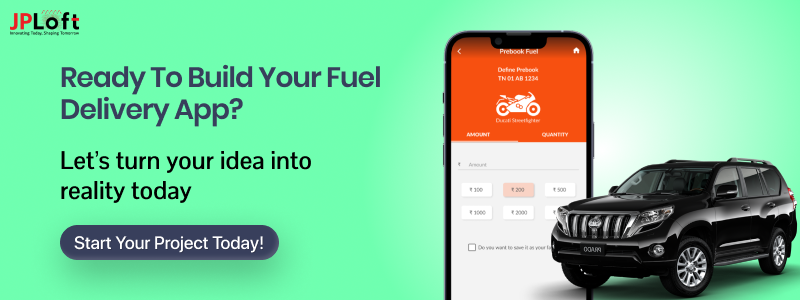



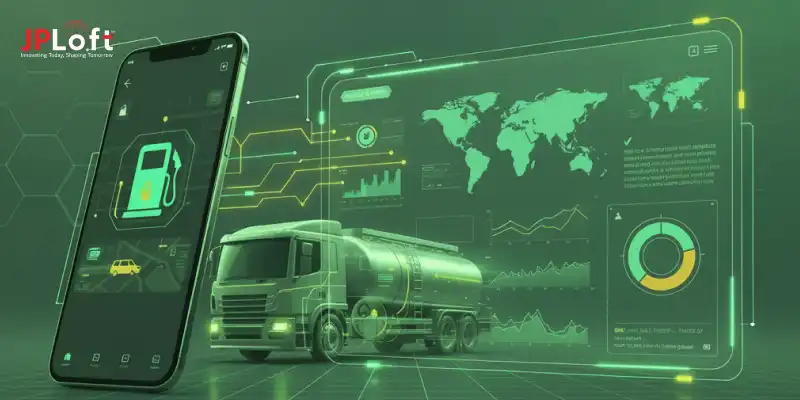

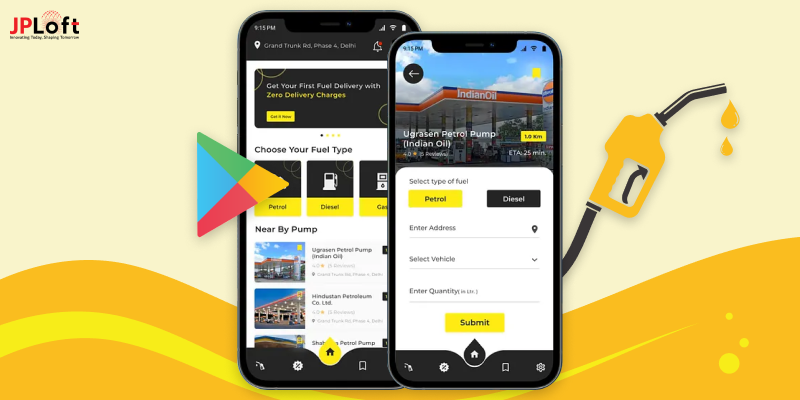


Share this blog